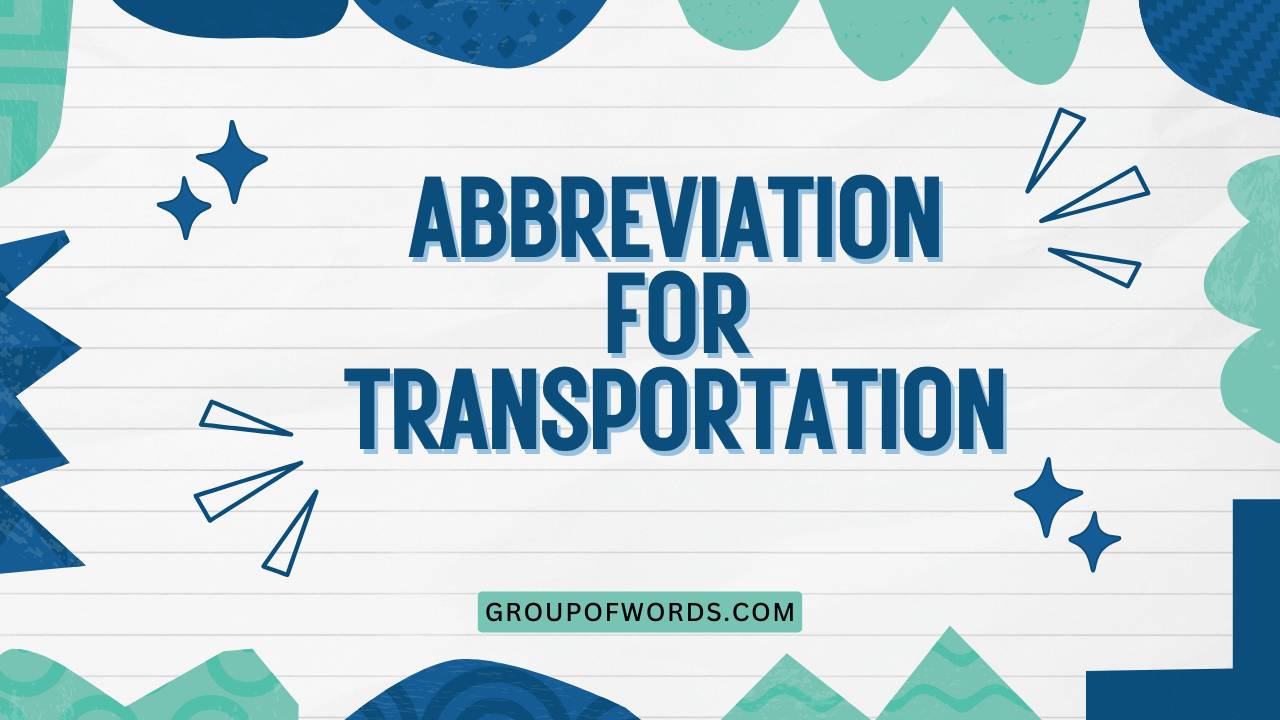Abbreviations for Transportation: A Comprehensive Guide
Understanding abbreviations for different modes of transportation is crucial for effective communication in various contexts, from travel planning to logistics and urban development. This knowledge helps us to quickly and accurately convey information, saving time and space in written and spoken language.
This article offers a detailed exploration of common transportation abbreviations, their meanings, and proper usage. It is designed for English language learners, travelers, logistics professionals, and anyone interested in enhancing their communication skills.
Whether you’re booking a flight, reading a traffic report, or discussing shipping options, familiarity with these abbreviations is essential. This guide will help you confidently navigate the world of transportation terminology and avoid misunderstandings.
By the end of this article, you’ll have a solid understanding of the most frequently used abbreviations and how to use them correctly in various situations.
Table of Contents
- Definition of Transportation Abbreviations
- Structural Breakdown of Abbreviations
- Types and Categories of Transportation Abbreviations
- Examples of Transportation Abbreviations
- Usage Rules for Transportation Abbreviations
- Common Mistakes with Transportation Abbreviations
- Practice Exercises
- Advanced Topics in Transportation Abbreviations
- Frequently Asked Questions
- Conclusion
Definition of Transportation Abbreviations
A transportation abbreviation is a shortened form of a word or phrase commonly used to represent a mode of transport, a related service, or a logistical term. Abbreviations are used to save space, time, and effort in writing and speaking, especially in contexts where the full term would be cumbersome or repetitive.
These abbreviations can refer to specific types of vehicles, transportation infrastructure, regulatory bodies, or industry-specific jargon.
The function of these abbreviations is primarily to simplify communication and improve efficiency within the transportation sector and related fields. They enable professionals, travelers, and the general public to quickly understand and convey information about various aspects of transportation.
Abbreviations are found in timetables, shipping documents, traffic reports, news articles, and everyday conversations.
Transportation abbreviations are classified based on the mode of transport they represent. These categories include air, road, rail, water, and intermodal transport.
Each category has its own set of commonly used abbreviations that are specific to the terminology and practices within that mode. For example, aviation uses abbreviations like “ETA” (Estimated Time of Arrival) and “ATC” (Air Traffic Control), while road transport uses abbreviations like “LTL” (Less Than Truckload) and “DOT” (Department of Transportation).
Structural Breakdown of Abbreviations
Transportation abbreviations are typically formed using one or more of the following methods:
- Initialism: Using the first letter of each word in a phrase (e.g., DOT for Department of Transportation).
- Acronym: Forming a new word from the first letters of a phrase (e.g., LORAN for Long Range Navigation).
- Truncation: Shortening a word by removing letters from the end (e.g., Rd for Road).
- Contraction: Shortening a word by removing letters from the middle (e.g., Int’l for International).
The structure of an abbreviation can also include numbers or symbols to further specify the meaning. For example, “4PL” stands for Fourth-Party Logistics, which indicates a specific type of logistics provider.
The use of numbers and symbols is particularly common in the logistics and supply chain sectors.
It is important to note that some abbreviations may have multiple meanings depending on the context. For instance, “RT” can refer to “Round Trip” in the context of travel or “Road Train” in the context of trucking.
Therefore, understanding the context in which an abbreviation is used is crucial for accurate interpretation.
Types and Categories of Transportation Abbreviations
Transportation abbreviations can be categorized by the mode of transport they represent. Here’s a breakdown of the major categories:
Air Transport Abbreviations
Air transport abbreviations are commonly used in aviation, air cargo, and passenger travel. These abbreviations are essential for air traffic control, flight planning, and communication between airlines, airports, and passengers.
Examples include airport codes (e.g., JFK for John F. Kennedy International Airport), airline codes (e.g., AA for American Airlines), and operational terms (e.g., ETA for Estimated Time of Arrival).
Road Transport Abbreviations
Road transport abbreviations are prevalent in trucking, logistics, and traffic management. They are used to describe vehicle types, shipping terms, regulatory bodies, and road infrastructure.
Familiarity with these abbreviations is crucial for truck drivers, logistics managers, and anyone involved in the transportation of goods by road. Examples include “LTL” (Less Than Truckload), “DOT” (Department of Transportation), and “HOV” (High Occupancy Vehicle).
Rail Transport Abbreviations
Rail transport abbreviations are used in the railway industry to refer to train types, railway lines, signaling systems, and operational procedures. These abbreviations are essential for railway engineers, train operators, and railway maintenance staff.
Examples include “EMU” (Electric Multiple Unit), “FRA” (Federal Railroad Administration), and “UIC” (International Union of Railways).
Water Transport Abbreviations
Water transport abbreviations are common in shipping, maritime logistics, and port operations. They are used to describe ship types, shipping terms, port facilities, and maritime regulations.
These abbreviations are essential for ship captains, port authorities, and shipping companies. Examples include “TEU” (Twenty-foot Equivalent Unit), “IMO” (International Maritime Organization), and “RoRo” (Roll-on/Roll-off).
Intermodal Transport Abbreviations
Intermodal transport abbreviations are used to describe the combination of different modes of transport in a single journey. These abbreviations are crucial for logistics managers who coordinate the movement of goods using multiple modes of transport, such as road, rail, and sea.
Examples include “TOFC” (Trailer On Flat Car), “COFC” (Container On Flat Car), and “PBO” (Projected Build Out).
Examples of Transportation Abbreviations
Here are some detailed examples of transportation abbreviations, organized by category:
Air Transport Examples
The following table provides examples of common air transport abbreviations and their meanings. Understanding these abbreviations is essential for anyone involved in air travel or the aviation industry.
| Abbreviation | Meaning | Example Sentence |
|---|---|---|
| ETA | Estimated Time of Arrival | The ETA for flight BA249 is 14:30. |
| ETD | Estimated Time of Departure | The ETD for flight LH100 is delayed by one hour. |
| ATC | Air Traffic Control | ATC instructed the pilot to change course. |
| ICAO | International Civil Aviation Organization | ICAO sets the standards for international aviation. |
| IATA | International Air Transport Association | IATA provides guidelines for airline operations. |
| APU | Auxiliary Power Unit | The APU provides power to the aircraft on the ground. |
| MEL | Minimum Equipment List | The aircraft was cleared for departure despite an item on the MEL. |
| NOTAM | Notice to Airmen | Pilots should check NOTAMs before each flight. |
| TMA | Terminal Control Area | The aircraft entered the TMA at 10,000 feet. |
| VOR | VHF Omnidirectional Range | The pilot used the VOR to navigate to the airport. |
| ILS | Instrument Landing System | The airport is equipped with an ILS for low-visibility landings. |
| RNAV | Area Navigation | RNAV allows aircraft to fly on any desired flight path. |
| ADS-B | Automatic Dependent Surveillance-Broadcast | ADS-B provides real-time aircraft tracking information. |
| SOP | Standard Operating Procedure | Pilots must follow the SOPs for all flight operations. |
| TSA | Transportation Security Administration | The TSA is responsible for security at airports. |
| Pax | Passengers | The flight was fully booked with 250 pax on board. |
| Cargo | Goods transported by air | The cargo plane was delayed due to bad weather. |
| AOG | Aircraft on Ground | The flight was delayed due to an AOG situation. |
| MTOW | Maximum Takeoff Weight | The aircraft was loaded to its MTOW. |
| ATIS | Automatic Terminal Information Service | Pilots listen to the ATIS to get the latest weather and airport information. |
| FIR | Flight Information Region | The aircraft entered the FIR controlled by the next air traffic control center. |
| EASA | European Union Aviation Safety Agency | EASA sets the safety standards for aviation in Europe. |
| FAA | Federal Aviation Administration | The FAA regulates civil aviation in the United States. |
| GA | General Aviation | The airport also caters to GA aircraft. |
| RAMP | Area around the airport where aircraft park | Ground crew were working on the RAMP. |
Road Transport Examples
The following table provides examples of common road transport abbreviations and their meanings. Understanding these abbreviations is crucial for anyone involved in road transport and logistics.
| Abbreviation | Meaning | Example Sentence |
|---|---|---|
| LTL | Less Than Truckload | We shipped the goods via LTL freight. |
| FTL | Full Truckload | For large shipments, FTL is more cost-effective. |
| DOT | Department of Transportation | The truck driver complied with DOT regulations. |
| HOV | High Occupancy Vehicle | The HOV lane is reserved for vehicles with multiple passengers. |
| VIN | Vehicle Identification Number | The VIN is used to identify the vehicle. |
| CDL | Commercial Driver’s License | A CDL is required to drive a commercial vehicle. |
| HAZMAT | Hazardous Materials | The truck was carrying HAZMAT cargo. |
| GVWR | Gross Vehicle Weight Rating | The GVWR indicates the maximum weight the vehicle can carry. |
| ELD | Electronic Logging Device | Truck drivers are required to use an ELD to track their hours of service. |
| TL | Truckload | We need to ship a TL of goods to the warehouse. |
| BOL | Bill of Lading | The BOL is a receipt for the shipment. |
| POD | Proof of Delivery | We require a POD for all shipments. |
| TMS | Transportation Management System | The company uses a TMS to manage its freight operations. |
| GPS | Global Positioning System | The truck is equipped with a GPS tracking device. |
| ETA | Estimated Time of Arrival | The ETA for the delivery is tomorrow morning. |
| OOG | Out of Gauge | The shipment was flagged as OOG because of its size. |
| OSOW | Over Size Over Weight | The OSOW load required special permits. |
| RFID | Radio Frequency Identification | RFID tags are used to track the location of the goods. |
| RTE | Route | The driver followed the designated RTE. |
| D.O.T. | Department of Transportation | The driver was stopped for a D.O.T. inspection. |
| TPMS | Tire Pressure Monitoring System | The truck’s TPMS alerted the driver to low tire pressure. |
| DMV | Department of Motor Vehicles | The driver renewed his license at the DMV. |
| HAZMAT | Hazardous Material | The truck was placarded to indicate it was carrying HAZMAT. |
| CDL | Commercial Driver’s License | The driver’s CDL was suspended due to multiple traffic violations. |
| ABS | Anti-lock Braking System | The truck was equipped with an ABS. |
Rail Transport Examples
The following table provides examples of common rail transport abbreviations and their meanings. Understanding these abbreviations is crucial for anyone involved in the railway industry.
| Abbreviation | Meaning | Example Sentence |
|---|---|---|
| EMU | Electric Multiple Unit | The EMU is used for commuter services. |
| DMU | Diesel Multiple Unit | The DMU is used on non-electrified lines. |
| FRA | Federal Railroad Administration | The FRA regulates the railway industry in the United States. |
| UIC | International Union of Railways | The UIC sets standards for international railway operations. |
| TTC | Train Traffic Control | TTC is responsible for managing train movements. |
| ATC | Automatic Train Control | ATC systems enhance railway safety. |
| ETCS | European Train Control System | ETCS is a standardized train control system used in Europe. |
| CBTC | Communication-Based Train Control | CBTC systems allow for higher train frequencies. |
| LRT | Light Rail Transit | The city is expanding its LRT network. |
| HSR | High-Speed Rail | HSR provides fast and efficient transportation between cities. |
| RDC | Rail Diesel Car | The RDC is a self-propelled railcar. |
| MOW | Maintenance of Way | The MOW crew is responsible for track maintenance. |
| RWC | Rail Wheel Contouring | RWC helps to reduce noise and vibration. |
| TSI | Technical Specifications for Interoperability | The TSI ensures compatibility between different railway systems. |
| RCF | Rolling Contact Fatigue | RCF is a common cause of rail defects. |
| CWR | Continuous Welded Rail | CWR provides a smoother ride and reduces track maintenance. |
| UIC | International Union of Railways | The UIC has established numerous standards for railway equipment. |
| TEU | Twenty-Foot Equivalent Unit | The number of TEU transported by rail has increased. |
| COFC | Container on Flat Car | COFC is a common method of transporting containers by rail. |
| TOFC | Trailer on Flat Car | TOFC allows trucks trailers to be transported by rail. |
| BNSF | Burlington Northern Santa Fe Railway | The BNSF is one of the largest freight railroad networks in North America. |
| UP | Union Pacific Railroad | The UP is another major freight railroad in the United States. |
| Amtrak | National Railroad Passenger Corporation | Amtrak provides passenger rail service in the United States. |
| LCL | Less than Carload | The shipment was sent as LCL. |
| CAR | Complete Auto Rack | The train transported several CARs. |
Water Transport Examples
The following table provides examples of common water transport abbreviations and their meanings. Understanding these abbreviations is crucial for anyone involved in maritime transport and logistics.
| Abbreviation | Meaning | Example Sentence |
|---|---|---|
| TEU | Twenty-foot Equivalent Unit | The port handled over a million TEUs last year. |
| IMO | International Maritime Organization | The IMO sets standards for maritime safety and security. |
| RoRo | Roll-on/Roll-off | The RoRo ship is designed to carry vehicles. |
| LOA | Length Overall | The LOA of the ship is 200 meters. |
| GT | Gross Tonnage | The GT of the ship is a measure of its size. |
| DWT | Deadweight Tonnage | The DWT of the ship indicates its cargo-carrying capacity. |
| ULCC | Ultra Large Crude Carrier | The ULCC is the largest type of oil tanker. |
| VLCC | Very Large Crude Carrier | The VLCC is a common type of oil tanker. |
| LNG | Liquefied Natural Gas | The LNG carrier transports natural gas in liquid form. |
| LPG | Liquefied Petroleum Gas | The LPG carrier transports petroleum gas in liquid form. |
| ETA | Estimated Time of Arrival | The ETA of the ship is next Tuesday. |
| ETD | Estimated Time of Departure | The ETD of the ship is tomorrow morning. |
| POL | Port of Loading | The POL is Shanghai. |
| POD | Port of Discharge | The POD is Rotterdam. |
| Bunker | Fuel for ships | The ship needed to take on more bunker. |
| OOW | Officer of the Watch | The OOW is responsible for the safe navigation of the ship. |
| ISM | International Safety Management Code | The company complies with the ISM Code. |
| ISPS | International Ship and Port Facility Security Code | The port follows the ISPS Code. |
| MARPOL | International Convention for the Prevention of Pollution from Ships | The ship complies with MARPOL regulations. |
| RORO | Roll-on Roll-off | The RORO ferry transported cars across the channel. |
| TEU | Twenty-Foot Equivalent Unit | The container ship can carry over 10,000 TEU. |
| IMO | International Maritime Organization | The IMO sets the standards for maritime safety and security. |
| LNG | Liquified Natural Gas | The LNG carrier transports natural gas in liquid form. |
| ULCC | Ultra Large Crude Carrier | The ULCC is one of the largest types of oil tankers. |
| FPSO | Floating Production Storage and Offloading | The FPSO is used for offshore oil and gas production. |
Intermodal Transport Examples
The following table provides examples of common intermodal transport abbreviations and their meanings. Understanding these abbreviations is crucial for anyone involved in logistics and supply chain management.
| Abbreviation | Meaning | Example Sentence |
|---|---|---|
| TOFC | Trailer On Flat Car | The shipment was transported via TOFC. |
| COFC | Container On Flat Car | COFC is a common method of transporting containers by rail. |
| PBO | Projected Build Out | The PBO for the new intermodal terminal is next year. |
| IMDG | International Maritime Dangerous Goods Code | The IMDG Code regulates the transport of dangerous goods. |
| SCAC | Standard Carrier Alpha Code | The SCAC is used to identify freight carriers. |
| BOL | Bill of Lading | The BOL is required for all intermodal shipments. |
| EDI | Electronic Data Interchange | EDI is used to exchange information between different parties in the supply chain. |
| THC | Terminal Handling Charge | The THC covers the cost of handling the container at the terminal. |
| DTHC | Destination Terminal Handling Charge | The DTHC is charged at the destination terminal. |
| OTHC | Origin Terminal Handling Charge | The OTHC is charged at the origin terminal. |
| BAF | Bunker Adjustment Factor | The BAF is an adjustment to the freight rate to account for fluctuations in fuel prices. |
| CAF | Currency Adjustment Factor | The CAF is an adjustment to the freight rate to account for fluctuations in currency exchange rates. |
| FCL | Full Container Load | The shipment was transported as FCL. |
| LCL | Less Than Container Load | The shipment was consolidated into an LCL shipment. |
| CFS | Container Freight Station | The CFS is where LCL shipments are consolidated and deconsolidated. |
| IMO | International Maritime Organization | The IMO sets standards for maritime safety and security. |
| IATA | International Air Transport Association | IATA provides guidelines for airline operations. |
| ADR | European Agreement concerning the International Carriage of Dangerous Goods by Road | The shipment of dangerous goods by road must comply with ADR regulations. |
| RID | Regulations concerning the International Carriage of Dangerous Goods by Rail | The shipment of dangerous goods by rail must comply with RID regulations. |
| TAPA | Transported Asset Protection Association | The company is certified by TAPA. |
| WMS | Warehouse Management System | The company uses a WMS to manage its inventory. |
| 3PL | Third-Party Logistics | The company outsources its logistics to a 3PL provider. |
| 4PL | Fourth-Party Logistics | A 4PL provider manages the entire supply chain. |
| SCM | Supply Chain Management | Effective SCM is essential for efficient intermodal transportation. |
| KPI | Key Performance Indicator | The company monitors KPIs to track the performance of its supply chain. |
Usage Rules for Transportation Abbreviations
When using transportation abbreviations, it’s important to follow certain rules to ensure clarity and avoid confusion:
- Context is key: Always consider the context in which you’re using the abbreviation. Some abbreviations have multiple meanings, so the context will help clarify the intended meaning.
- Consistency: Be consistent in your use of abbreviations throughout a document or conversation. Don’t switch between using the abbreviation and the full term without a clear reason.
- Define unfamiliar abbreviations: If you’re using an abbreviation that may not be familiar to your audience, define it the first time you use it. For example, “The Estimated Time of Arrival (ETA) is 14:00.”
- Capitalization: Most transportation abbreviations are written in all capital letters (e.g., ETA, DOT, IMO). However, some abbreviations, especially those derived from proper nouns, may use mixed case (e.g., Amtrak).
- Punctuation: Generally, abbreviations do not require periods (e.g., DOT, not D.O.T.). However, some style guides may recommend using periods for certain abbreviations.
- Pluralization: To pluralize an abbreviation, simply add an “s” at the end (e.g., ETAs, BOLs). Do not use an apostrophe (e.g., not ETA’s).
It’s also important to be aware of industry-specific conventions. Different sectors within the transportation industry may have their own preferred abbreviations and usage guidelines.
Common Mistakes with Transportation Abbreviations
Here are some common mistakes to avoid when using transportation abbreviations:
| Incorrect | Correct | Explanation |
|---|---|---|
| The D.O.T. inspected the truck. | The DOT inspected the truck. | Periods are generally not used in transportation abbreviations. |
| The ETA’s are subject to change. | The ETAs are subject to change. | Use “s” to pluralize abbreviations, not an apostrophe. |
| The estimated time of arrival (eta) is 14:00. | The Estimated Time of Arrival (ETA) is 14:00. | Use all capital letters for transportation abbreviations. |
| The ship will arrive at the POD next week, but what is POD? | The ship will arrive at the Port of Discharge (POD) next week. | Define unfamiliar abbreviations the first time you use them. |
| We shipped the goods via lessthan truckload freight. | We shipped the goods via LTL freight. | Use the correct abbreviation instead of a shortened version of the full term. |
By being aware of these common mistakes, you can improve the clarity and accuracy of your communication.
Practice Exercises
Test your knowledge of transportation abbreviations with these practice exercises:
Exercise 1: Multiple Choice
| Question | A | B | C | D | Answer |
|---|---|---|---|---|---|
| 1. What does ETA stand for? | Estimated Travel Agency | Estimated Time of Arrival | Extra Time Allowance | Early Transport Arrangement | B |
| 2. What does DOT stand for? | Department of Trade | Department of Transport | Department of Transportation | Division of Traffic | C |
| 3. What does LTL stand for? | Less Than Load | Large Truckload | Less Than Truckload | Limited Time Logistics | C |
| 4. What does IMO stand for? | International Monetary Organization | International Maritime Organization | Internal Management Office | Integrated Maritime Operations | B |
| 5. What does TOFC stand for? | Trailer On Flat Car | Trucking Over Freight Costs | Total Operating Fuel Consumption | Transport Of Foreign Cargo | A |
| 6. What does ATC stand for in aviation? | Automatic Train Control | Air Traffic Control | Automated Transit Corporation | Advanced Transport Concepts | B |
| 7. What does VIN stand for? | Vehicle Identification Number | Vendor Identification Number | Volume Index Number | Value Investment Note | A |
| 8. What does HAZMAT stand for? | Hazardous Materials | Highly Automated Machines | Heavy Asset Management | Harmonized Asset Tracking | A |
| 9. What does TEU stand for? | Twenty-foot Equivalent Unit | Total Energy Usage | Transportation Efficiency Upgrade | Terminal Equipment Unit | A |
| 10. What does GPS stand for? | Global Positioning System | General Planning Strategy | Government Policy Statement | Guided Path System | A |
Exercise 2: Fill in the Blanks
Fill in the blanks with the correct transportation abbreviation.
- The __________ for the flight is 16:00. (Estimated Time of Arrival)
- The truck driver must comply with __________ regulations. (Department of Transportation)
- We shipped the goods via __________ freight. (Less Than Truckload)
- The __________ sets standards for maritime safety. (
International Maritime Organization)
- The goods were transported via __________. (Trailer On Flat Car)
Advanced Topics in Transportation Abbreviations
For those interested in a deeper understanding of transportation abbreviations, here are some advanced topics to explore:
- Historical Evolution: Research the origins and evolution of specific transportation abbreviations. How did they come into use, and how have their meanings changed over time?
- Regional Variations: Investigate how transportation abbreviations may vary in different regions or countries. Are there abbreviations that are commonly used in one part of the world but not in others?
- Regulatory Frameworks: Explore the regulatory frameworks that govern the use of transportation abbreviations. Are there any legal or industry standards that dictate how certain abbreviations must be used?
- Technological Advancements: Consider how technological advancements are impacting the use of transportation abbreviations. Are new abbreviations being created to describe emerging technologies and practices?
- Cross-Cultural Communication: Analyze the challenges of using transportation abbreviations in cross-cultural communication. How can you ensure that your audience understands the abbreviations you’re using, even if they come from a different cultural background?
By delving into these advanced topics, you can gain a more nuanced understanding of the role that transportation abbreviations play in the modern world.
Frequently Asked Questions
Q: Are periods necessary in transportation abbreviations?
A: Generally, periods are not necessary in transportation abbreviations (e.g., DOT, not D.O.T.). However, some style guides may recommend using periods for certain abbreviations.
It’s important to be consistent in your usage.
Q: How do you pluralize transportation abbreviations?
A: To pluralize an abbreviation, simply add an “s” at the end (e.g., ETAs, BOLs). Do not use an apostrophe (e.g., not ETA’s).
Q: What should I do if I don’t know the meaning of a transportation abbreviation?
A: If you’re unsure of the meaning of a transportation abbreviation, look it up in a glossary or online resource. You can also ask someone who is familiar with the transportation industry.
Q: Are transportation abbreviations case-sensitive?
A: Most transportation abbreviations are written in all capital letters (e.g., ETA, DOT, IMO). However, some abbreviations, especially those derived from proper nouns, may use mixed case (e.g., Amtrak).
Q: How can I stay up-to-date on the latest transportation abbreviations?
A: Stay informed by reading industry publications, attending conferences, and networking with professionals in the transportation sector. You can also follow relevant organizations and associations on social media.
Conclusion
Understanding transportation abbreviations is essential for effective communication in various contexts, from travel planning to logistics and urban development. By mastering the definitions, structural breakdown, and usage rules of these abbreviations, you can confidently navigate the world of transportation terminology and avoid misunderstandings.
This guide has provided a comprehensive overview of common transportation abbreviations, organized by category, along with practical examples and exercises to reinforce your learning.
Whether you’re a student, a professional, or simply someone interested in enhancing your communication skills, we hope this article has been a valuable resource. Remember to always consider the context in which you’re using abbreviations, define unfamiliar terms, and stay up-to-date on the latest industry trends.
With a solid understanding of transportation abbreviations, you’ll be well-equipped to communicate effectively in the ever-evolving world of transportation.






